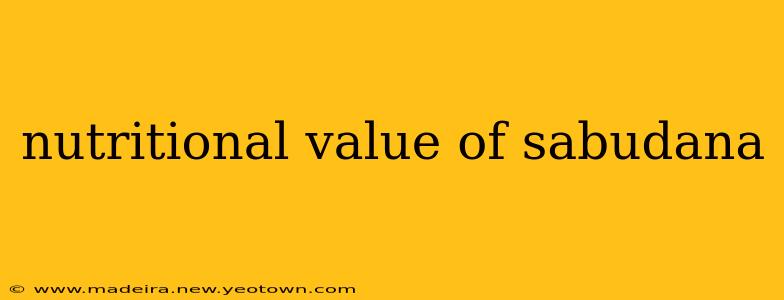Sabudana, also known as sago pearls, isn't just a culinary staple in many parts of the world; it's a surprisingly nutritious food with a unique profile. Often used in traditional dishes, its subtle flavor and versatility make it a fascinating ingredient to explore. But beyond its culinary appeal lies a wealth of nutritional benefits that often go unnoticed. Let's embark on a journey to uncover the secrets of this often-underappreciated food.
What is Sabudana Made Of?
Before we delve into the nutritional aspects, understanding the origins of sabudana is crucial. It's derived from the pith of the cassava or tapioca root, a starchy tuber native to South America. The process involves extracting the starch, washing it, and then shaping it into the familiar pearly granules. This process essentially leaves behind a concentrated source of carbohydrates, albeit with a unique nutritional makeup compared to other starchy foods.
What are the Nutritional Benefits of Sabudana?
Sabudana is primarily a carbohydrate source, providing energy for the body. However, it also boasts a modest amount of other essential nutrients:
-
Carbohydrates: As mentioned, sabudana is rich in carbohydrates, making it a good source of quick energy. This is particularly beneficial for athletes or individuals engaging in strenuous physical activity.
-
Vitamins and Minerals: While not abundant in vitamins and minerals compared to fruits and vegetables, sabudana does contain small amounts of potassium, iron, and calcium. These micronutrients play crucial roles in maintaining overall health.
-
Low in Fat and Protein: Sabudana is relatively low in both fat and protein content. While not a primary source of either, this makes it a suitable food for those watching their fat intake.
-
Gluten-Free: A significant advantage of sabudana is its gluten-free nature. This makes it a suitable dietary option for people with celiac disease or gluten intolerance.
Is Sabudana Good for Weight Loss?
This is a frequently asked question. While sabudana is a source of carbohydrates, it’s crucial to remember that moderation is key. Its high carbohydrate content makes it calorie-dense, and overconsumption could hinder weight loss efforts. It can be part of a balanced diet for weight management but shouldn't be relied upon as a standalone weight-loss solution.
Does Sabudana Help in Digestion?
The digestibility of sabudana is a topic of debate. While some find it easily digestible, others report digestive discomfort after consumption. This can vary depending on individual tolerance and the preparation method. It's essential to listen to your body and adjust your intake accordingly.
What are the Potential Side Effects of Eating Sabudana?
While generally safe for consumption, excessive consumption of sabudana can potentially lead to:
- Digestive issues: As mentioned, some individuals might experience bloating, gas, or other digestive discomfort.
- Blood sugar spikes: The high carbohydrate content can lead to blood sugar spikes, particularly for people with diabetes.
Moderation and mindful consumption are key to preventing these side effects.
How to Incorporate Sabudana into Your Diet?
Sabudana's versatility shines through its various culinary applications. From the popular Sabudana Khichdi to various snacks and appetizers, its subtle flavor allows it to blend seamlessly with diverse spices and flavors. Remember to cook it properly to ensure optimal digestibility and avoid potential digestive issues.
Conclusion: Sabudana - A Balanced Perspective
Sabudana offers a unique nutritional profile, contributing energy and a few essential nutrients to the diet. However, its high carbohydrate content and potential for digestive discomfort necessitate mindful consumption and moderation. Like any food, it should be part of a balanced diet rather than a sole dietary focus. By understanding its strengths and limitations, you can harness the nutritional benefits of sabudana while mitigating potential downsides.

